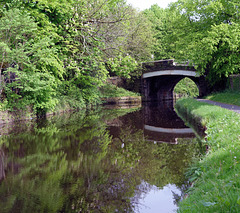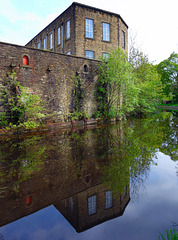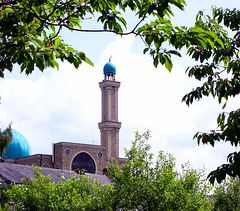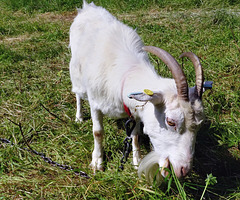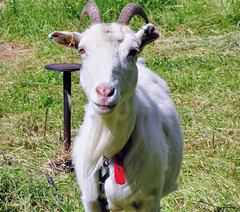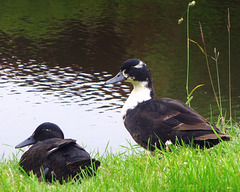
Snapshots
Reflections.
| |
|
|
|
The Leeds-Liverpool canal near Nelson, Lancashire, in the North-West of England, photographed with a Sony RX100 compact camera and processed with Nikon Capture NX2.
Bluebell wood.
| |
|
|
|
Bluebells (Hyacinthoides) photographed near the village of Barrowford in Pendle district, North-West England. Photographed with a Sony RX100 compact camera and processed with Nikon Capture NX2 software.
Reflections.
| |
|
|
|
This scene was photographed on the Leeds-Liverpool canal near the town of Nelson, Lancashire, in the North-West of England. The building is one of many former textile mills situated along this canal, most of which are now derelict since the cotton industry, once the main source of employment in this area has declined to almost nothing. Many former mills have been demolished and others are being converted into flats / apartments.
Photographed with a Sony RX100 compact camera and processed with Nikon Capture NX2.
Coastal erosion at Seahouses.
| |
|
|
|
Coastal erosion at Seahouses, Northumberland.....these buildings won't be around much longer !!
A popular fishing port and seaside resort on the Northumbrian coast, the village of Seahouses is a lovely spot. Daily sailings leave from Seahouses harbour to visit the nearby nature reserve and seabird sanctuary on the Farne Islands. Some boat trips allow visitors to land on the islands to explore on foot. Just two miles up the coast is Bamburgh Castle and the dramatic ruins of Dunstanburgh Castle are several miles further south.
(Britain Express).
Farne Islands ferry.
| |
|
|
|
One of the Ferry fleet, "Glad Tidings", which runs between the coastal town of Seahouses and the nearby Farne Islands. The islands are home to many species of birds and thousands of Grey Seals (and they are the former home of at least 3 Saints).
The Islands are also famous for their association with Grace Darling (see 1st link below) who, with her lighthouse-keeper father William, saved the lives of 9 people in 1830 when the ship "Forfarshire" went aground and split apart on nearby rocks during a violent storm. Despite weather which was too severe for the Seahouses lifeboat to be launched, Grace and her father rowed to the wreck in a small boat and managed to save the survivors.
en.wikipedia.org/wiki/Grace_Darling
en.wikipedia.org/wiki/Farne_islands
Digitalis (Foxglove).
| |
|
|
|
Digitalis is a genus of about 20 species of herbaceous perennials, shrubs, and biennials commonly called foxgloves. This genus is native to most parts of Western and South-Western Europe, Western and central Asia, Australasia and North-Western Africa. The scientific name means "finger-like" and refers to the ease with which a flower of Digitalis can be fitted over a human fingertip. The flowers are produced on a tall spike, are tubular and vary in colour with species from purple to pink, white, and yellow. The best-known species is the common foxglove, Digitalis purpurea. This biennial plant is often grown as an ornamental plant due to its vivid flowers which range in colour from various purple tints through various shades of light grey and pure white. The flowers can also possess various marks and spots.
A group of medicines extracted from foxglove plants are called Digitalin. It is used to increase cardiac contractility and as an antiarrhythmic agent to control the heart rate. Digitalis is often prescribed for patients in atrial fibrillation, especially if they have been diagnosed with congestive heart failure.
(Wikipedia).
Jamia Sultania Mosque.
| |
|
|
|
The Jamia Sultania Mosque in Brierfield, North-West England, photographed with a Sony RX100 compact camera and processed with Nikon Capture NX2.
"Bearded Lady".
| |
|
|
|
We found this "nanny" goat (and 3 others) tethered on a long chain in a field during a walk to Raven's Clough Wood yesterday. She was very nervous at first but I managed to "bribe" her with some juicy grass which was out of her reach and eventually I was able to get within touching distance and take a few close-up photos. The "bleep" of the camera focussing startled her at first but the fresh grass proved too good to resist !
Photographed with a Sony RX100 compact camera and processed with Nikon Capture NX2.
Orchidaceae.
| |
|
|
|
Wild flowers photographed in Raven's Clough Wood near Brierfield in North-West England. I'm not certain what these are....they appear to be members of the Orchidaceae family (Orchids), most probably one of the "Marsh Orchids" (Dactylorhiza) which can be very variable in appearance and difficult to identify with certainty. These were growing in open deciduous woodland in a high and exposed location.
Camera: Sony RX100. Processed with Nikon Capture NX2.
My four-legged friend.
| |
|
|
|
Photographed in a field near Brierfield, North-West England, using a Sony RX100 compact camera and processed with Nikon Capture NX2. This was taken from close range and I think she was trying to decide whether or not my camera was edible. Goats will eat (or try to eat) almost anything !!
"Freedom Girl". (2 of 2)
| |
|
|
|
"Freedom Girl" is the first medallion in the Silver Bullet Silver Shield series done with full creative control given to American sculptress Heidi Wastweet. Heidi is known for her images of strong and beautiful women, most notably "Pandora Defiant". Now she has created a new beauty for a new generation.
Men have been known to fight to the death for women, treasure and freedom. Freedom Girl is a stunning combination of all three. Every aspect of Heidi's design brings out a gorgeous update of the classic Peace Dollar. The original Peace Dollar had her hair tied in a bun with an uncomfortable tiara perched on her head. Freedom Girl's hair is wild and free. Freedom Girl's parted lips and gaze of almost ecstasy looking forward to the future is so seductive, as Freedom should be. Even her shoulder arching forward brings out more emotion from this modern beauty. She is finished off with the modern cues of a hoop earring and a tattoo of the Trivium.
(Edited & shortened extract from an article at The Numismatic Bibliomania Society) .
This coin is created on the basis of the "Peace Dollar" which is regarded as one of the most beautiful coins in the world (struck by the U.S. mint after World War One to commemorate the "War to End All Wars"). These coins are made from 1 Troy ounce of 99.999% pure silver. The medieval Trivium design (on her shoulder) symbolizes the foundation for individual freedom from outside manipulation. These coins (A.K.A. "rounds" or "medallions") are not legal tender and have no "face value"....they are for collectors and investors in precious metals.
Niue Island crystal coin.
| |
|
|
|
The "Mysteries of Wawel" coin from Crystal Art.
Wawel is a fortified architectural complex erected over many centuries atop a limestone outcrop on the left bank of the Vistula river in Kraków, Poland, at an altitude of 228 metres above the sea level. The complex consists of many buildings and fortifications; the largest and best known of these are The Royal Castle and Wawel Cathedral which is the Basilica of St Stanisław and St Wacław. Some of the Wawel's oldest stone buildings such as the Rotunda of the Virgin Mary can be dated to 970AD. There are also wooden parts of the complex which date to about the 9th century. The castle itself has been described as "one of the most fascinating of all European castles." Wawel is a place of great significance to the Polish people: it first became a political power centre at the end of the first millennium AD and, in the 9th century, the principal fortified castrum of the Vistulans tribe. The first historical ruler Mieszko I of Poland of the Piast dynasty and his successors Boleslaw I the Brave and Mieszko II chose Wawel to be one of their residences. At the same time Wawel became one of the principal Polish centres of Christianity. The first early Romanesque buildings were erected there including a stone cathedral serving the bishopric of Kraków in the year 1000. From the reign of Casimir the Restorer Wawel became the leading political and administrative centre for the Polish State.
This pure silver 2 Troy-ounce coin depicts the fairytale Wawel Castle in a high-relief "antiqued" finish with the face-value of 2 Dollars and a portrait of Queen Elizabeth II. A different Red Agate crystal insert for each coin makes every coin unique. These coins are made by the Mint of Poland and issued by Niue Island (Approx. 800 miles East of Fiji, where they are legal tender) with an extremely limited mintage of just 999 pieces in the world.
Camera Sony RX100: Processed with NIkon Capture NX2.
Shipwreck silver.
| |
|
|
|
The 300 ft S.S. Gairsoppa was launched in 1919 by the British India Steam Navigation Company Ltd. of London, a company that got its start transporting mail between Calcutta and Rangoon. As World War II unfolded the United Kingdom enlisted the ship to help out with the war effort. Towards the beginning of the war (December of 1940), the ship was loaded full of supplies which included pig iron, tea and over 7 million ounces of silver in the form of ingots. Today the value of its cargo has been estimated at £150,000,000 and is believed to be one of the richest of any sunken vessel.
On its trip from Calcutta to Britain the ship began to run low on fuel. It was forced to set a new course on the most direct route to port. As the ship headed towards the British Isles it was spotted by German aircraft which then relayed its position to a U-Boat which was in the area. The Gairsoppa was hit by a torpedo and later sunk on February 17, 1941, approximately 300 miles off the coast of Galway. Gairsoppa lay at a depth of some 2.9 miles (deeper even than the Titanic) on the bottom of the Atlantic for more than 70 years until it was finally recovered.
In 2010 the British Government sought out the help of Florida-based Odyssey Marine Exploration to help locate the ship and try to recover the 110+ tons of precious silver. They succeeded in 2012 and ended up recovering nearly all of the sunken silver. After the success of their recovery the company decided to commemorate the ship and its rich history by producing a number of silver bars and coins minted with actual silver from the recovery. This is one of those coins.
Camera Sony RX100: Processed with Nikon Capture NX2.
Ducks by the canal.
| |
|
|
|
Unidentified ducks, possibly Mallards crossed with some other breed as I haven't seen them in these colours before, photographed by the Leeds-Liverpool canal at Burnley, North-West England. Photographed with a Sony RX100 compact camera and processed with Nikon Capture NX2.
Posing for the camera.
| |
|
|
|
The domestic goat (Capra aegagrus hircus) is a subspecies of goat domesticated from the wild goat of southwest Asia and Eastern Europe. The goat is a member of the family Bovidae and is closely related to the sheep as both are in the goat-antelope subfamily Caprinae. There are over 300 distinct breeds of goat; they are one of the oldest domesticated species and have been used for their milk, meat, hair, and skins over much of the world. Goats are among the earliest animals domesticated by humans. The most recent genetic analysis confirms the archaeological evidence that the wild Bezoar ibex of the Zagros Mountains (Iran) are the likely origin of almost all domestic goats today.
Neolithic farmers began to herd wild goats for easy access to milk and meat, primarily, as well as for their dung which was used as fuel and their bones, hair, and sinew for clothing, building, and tools. The earliest remnants of domesticated goats dating 10,000 years before present are found in Ganj Dareh in Iran. Goat remains have been found at archaeological sites in Jericho, Djeitun and Çayönü, dating the domestication of goats in Western Asia at between 8000 and 9000 years ago. Studies of DNA evidence suggests 10,000 years ago as the domestication date. Historically, goat hide has been used for water and wine bottles in both travelling and transporting wine for sale. It has also been used to produce parchment.
(Wikipedia).
Camera: Sony RX100. Processed with Nikon Capture NX2 software.
Busy Bee.
| |
|
|
|
Bees are flying insects closely related to wasps and ants and are known for their role in pollination and for producing honey and beeswax. There are nearly 20,000 known species of bees in seven to nine recognized families, though many are undescribed and the actual number is probably higher. They are found on every continent except Antarctica, in every habitat on the planet that contains insect-pollinated flowering plants. Bees are adapted for feeding on nectar and pollen, the former primarily as an energy source and the latter primarily for protein and other nutrients. Most pollen is used as food for larvae. Bees have a long proboscis (a complex "tongue") that enables them to obtain the nectar from flowers. They have antennae almost universally made up of 13 segments in males and 12 in females. Bees all have two pairs of wings, the hind pair being the smaller of the two; in a very few species, one sex or caste has relatively short wings that make flight difficult or impossible, but none are wingless. The best-known bee species is the European honey bee, which, as its name suggests, produces honey, as do a few other types of bee. Human management of this species is known as beekeeping or apiculture.
(Wikipedia).
Camera: Sony RX100. Processed with Nikon Capture NX2.
Middle Britain (HFF).
| |
|
|
|
Photographed in the Lake District National Park town of Windermere, North-West England......exactly half-way ("as the crow flies") between the most Northern and Southern points of mainland Britain. Photographed with my first digital camera, an Olympus C1.....very low resolution by today's standards....only 1.3 megapixels !! Processed with Nikon Capture NX2.
York Minster's twin towers.
| |
|
|
|
The North and South towers of York Minster (see NOTES). There is also a higher central tower (out of shot to the left) with a viewing area which is open to the public. Photographed with a Panasonic TZ10 camera and processed with Nikon Capture NX2.
York Minster is a cathedral in York, England and is one of the largest of its kind in Northern Europe. The minster is the seat of the Archbishop of York, the second-highest office of the Church of England and is the cathedral for the Diocese of York. The title "minster" is attributed to churches established in the Anglo-Saxon period as missionary teaching churches and serves now as an honorific title.
The minster has a very wide Decorated Gothic nave and chapter house, a Perpendicular Gothic Quire and East end and Early English North and South transepts. The nave contains the West Window, constructed in 1338 and over the Lady Chapel in the East end is the Great East Window (finished in 1408), the largest expanse of medieval stained glass in the world. In the North transept is the Five Sisters Window, each lancet being over 52 feet (16 m) high. The South transept contains the famous rose window, while the West Window contains a heart-shaped design colloquially known as 'The Heart of Yorkshire'.
(Wikipedia).
Jump to top
RSS feed- Latest items - Subscribe to the latest items added to this album
- ipernity © 2007-2025
- Help & Contact
|
Club news
|
About ipernity
|
History |
ipernity Club & Prices |
Guide of good conduct
Donate | Group guidelines | Privacy policy | Terms of use | Statutes | In memoria -
Facebook
Twitter

